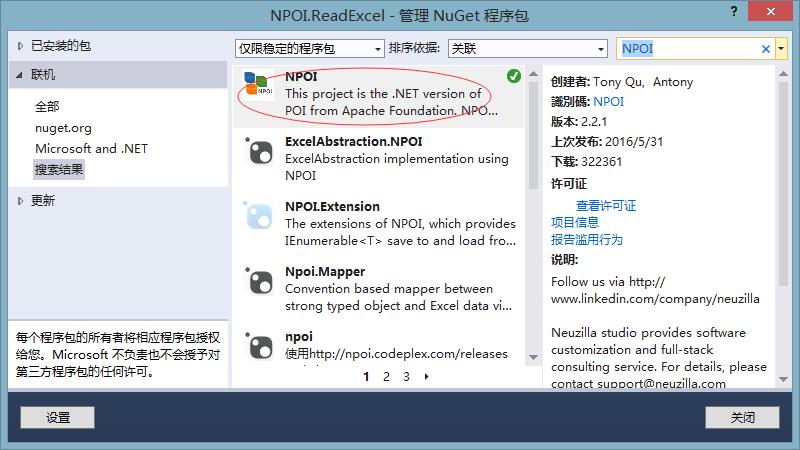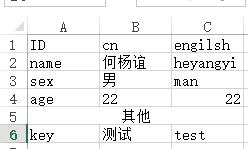使用NPOI读取Excel到DataTable
Posted
tags:
篇首语:本文由小常识网(cha138.com)小编为大家整理,主要介绍了使用NPOI读取Excel到DataTable相关的知识,希望对你有一定的参考价值。
一、NPOI介绍:
使用 NPOI 你就可以在没有安装 Office 或者相应环境的机器上对 WORD/EXCEL 文档进行读写。NPOI是构建在POI 3.x版本之上的,它可以在没有安装Office的情况下对Word/Excel文档进行读写操作
二、安装NPOI
新建控制台应用程序>管理NuGet程序包>搜索NPOI>安装NPOI

三.下面是我需要的读取的Excel文件,数据格式如下:

四.添加ExcelHelper类:

using System; using NPOI.SS.UserModel; using NPOI.XSSF.UserModel; using NPOI.HSSF.UserModel; using System.IO; using System.Data; namespace NPOI.ReadExcel { public class ExcelHelper : IDisposable { private string fileName = null; //文件名 private IWorkbook workbook = null; private FileStream fs = null; private bool disposed; public ExcelHelper(string fileName) { this.fileName = fileName; disposed = false; } /// <summary> /// 将DataTable数据导入到excel中 /// </summary> /// <param name="data">要导入的数据</param> /// <param name="isColumnWritten">DataTable的列名是否要导入</param> /// <param name="sheetName">要导入的excel的sheet的名称</param> /// <returns>导入数据行数(包含列名那一行)</returns> public int DataTableToExcel(DataTable data, string sheetName, bool isColumnWritten) { int i = 0; int j = 0; int count = 0; ISheet sheet = null; fs = new FileStream(fileName, FileMode.OpenOrCreate, FileAccess.ReadWrite); if (fileName.IndexOf(".xlsx") > 0) // 2007版本 workbook = new XSSFWorkbook(); else if (fileName.IndexOf(".xls") > 0) // 2003版本 workbook = new HSSFWorkbook(); try { if (workbook != null) { sheet = workbook.CreateSheet(sheetName); } else { return -1; } if (isColumnWritten == true) //写入DataTable的列名 { IRow row = sheet.CreateRow(0); for (j = 0; j < data.Columns.Count; ++j) { row.CreateCell(j).SetCellValue(data.Columns[j].ColumnName); } count = 1; } else { count = 0; } for (i = 0; i < data.Rows.Count; ++i) { IRow row = sheet.CreateRow(count); for (j = 0; j < data.Columns.Count; ++j) { row.CreateCell(j).SetCellValue(data.Rows[i][j].ToString()); } ++count; } workbook.Write(fs); //写入到excel return count; } catch (Exception ex) { Console.WriteLine("Exception: " + ex.Message); return -1; } } /// <summary> /// 将excel中的数据导入到DataTable中 /// </summary> /// <param name="sheetName">excel工作薄sheet的名称</param> /// <param name="isFirstRowColumn">第一行是否是DataTable的列名</param> /// <returns>返回的DataTable</returns> public DataTable ExcelToDataTable(string sheetName, bool isFirstRowColumn) { ISheet sheet = null; DataTable data = new DataTable(); int startRow = 0; try { fs = new FileStream(fileName, FileMode.Open, FileAccess.Read); if (fileName.IndexOf(".xlsx") > 0) // 2007版本 workbook = new XSSFWorkbook(fs); else if (fileName.IndexOf(".xls") > 0) // 2003版本 workbook = new HSSFWorkbook(fs); if (sheetName != null) { sheet = workbook.GetSheet(sheetName); if (sheet == null) //如果没有找到指定的sheetName对应的sheet,则尝试获取第一个sheet { sheet = workbook.GetSheetAt(0); } } else { sheet = workbook.GetSheetAt(0); } if (sheet != null) { IRow firstRow = sheet.GetRow(0); int cellCount = firstRow.LastCellNum; //一行最后一个cell的编号 即总的列数 if (isFirstRowColumn) { for (int i = firstRow.FirstCellNum; i < cellCount; ++i) { ICell cell = firstRow.GetCell(i); if (cell != null) { string cellValue = cell.StringCellValue; if (cellValue != null) { DataColumn column = new DataColumn(cellValue); data.Columns.Add(column); } } } startRow = sheet.FirstRowNum + 1; } else { startRow = sheet.FirstRowNum; } //最后一列的标号 int rowCount = sheet.LastRowNum; for (int i = startRow; i <= rowCount; ++i) { IRow row = sheet.GetRow(i); if (row == null) continue; //没有数据的行默认是null DataRow dataRow = data.NewRow(); for (int j = row.FirstCellNum; j < cellCount; ++j) { if (row.GetCell(j) != null) //同理,没有数据的单元格都默认是null dataRow[j] = row.GetCell(j).ToString(); } data.Rows.Add(dataRow); } } return data; } catch (Exception ex) { Console.WriteLine("Exception: " + ex.Message); return null; } } public void Dispose() { Dispose(true); GC.SuppressFinalize(this); } protected virtual void Dispose(bool disposing) { if (!this.disposed) { if (disposing) { if (fs != null) fs.Close(); } fs = null; disposed = true; } } } }
五,读取文件到DataTable:
using System; using System.Collections.Generic; using System.Data; using System.Linq; using System.Text; using System.Threading.Tasks; namespace NPOI.ReadExcel { class Program { static void Main(string[] args) { ExcelHelper excel_helper = new ExcelHelper(AppDomain.CurrentDomain.BaseDirectory + "test.xlsx"); DataTable dt = excel_helper.ExcelToDataTable("",true); List<string> tableList=GetColumnsByDataTable(dt); for (int i = 0; i < tableList.Count; i++) { foreach (DataRow item in dt.Rows) { try { if (item[0].ToString() != "") { if (i < tableList.Count - 1 & item[i + 1].ToString()!="") { Console.WriteLine(item[0].ToString()+"\\t"+item[i+1].ToString()); } } } catch (Exception ex) { } } Console.WriteLine(""); } Console.ReadKey(); } /// <summary> /// 根据datatable获得列名 /// </summary> /// <param name="dt">表对象</param> /// <returns>返回结果的数据列数组</returns> public static List<string> GetColumnsByDataTable(DataTable dt) { List<string> strColumns =new List<string> (); if (dt.Columns.Count > 0) { int columnNum = 0; columnNum = dt.Columns.Count;; for (int i = 0; i < dt.Columns.Count; i++) { strColumns.Add(dt.Columns[i].ColumnName); } } return strColumns; } } }
以上是关于使用NPOI读取Excel到DataTable的主要内容,如果未能解决你的问题,请参考以下文章
